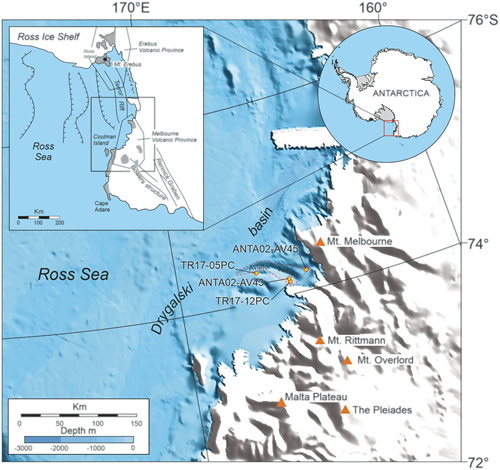Evidence for a large-magnitude Holocene eruption of Mount Rittmann(Antarctica): A volcanological reconstruction using the marine tephrarecord

Di Roberto A., P.G. Albert, E. Colizza, P. Del Carlo, G. Di Vincenzo, A. Gallerani, F. Giglio, G. Kuhn, P. Macrì, C.J. Manning, R. Melis, S. Miserocchi, B. Scateni, V.C. Smith, F. Torricella, A. Winkler (2020).
Quaternary Science Reviews, 250, https://doi.org/10.1016/j.quascirev.2020.106629
Abstract
In Antarctica, the near-source exposures of volcanic eruption deposits are often limited as they are not well preserved in the dynamic glacial environment, thus making volcanological reconstructions of explosive eruptions extremely challenging. Fortunately, pyroclastic deposits from explosive eruptions are preserved in Southern Ocean sediments surrounding Antarctica, and the tephrostratigraphy of these sequences offers crucial volcanological information including the timing and tempo of past eruptions, their magnitude, and eruption dynamics. Here we report the results of a tephrostratigraphy and tephrochronology study focused on four sediment cores recovered from the Wood Bay area in the western Ross Sea, Antarctica. In all these sedimentary sequences, we found a well-stratified primary tephra of considerable thickness, up to 80 cm, hereafter named the Aviator Tephra (AVT). According to the characteristics of the tephra deposit and its distribution, the AVT was associated with an eruption of considerable intensity, potentially representing one of the largest Holocene eruptions recorded in Antarctica. Based on the major and trace element geochemistry and the mineral assemblage of the tephra, Mount Rittmann was identified as the source of the AVT. A Holocene age of ∼11 ka was determined by radiocarbon dating organic material within the sediments and 40Ar-39Ar dating of alkali-feldspar crystals included in the tephra. Eruption dynamics were initially dominated by hydromagmatic magma fragmentation conditions producing a sustained, relatively wet and ash-rich eruptive cloud. The eruption then evolved into a highly energetic, relatively dry magmatic Plinian eruption. The last phase was characterized by renewed efficient magma-water interaction and/or collapse of the eruptive column producing pyroclastic density currents and associated co-ignimbritic plumes. The distal tephra deposits might be linked to the widespread lag breccia layer previously identified on the rim of the Mount Rittmann caldera which share the same geochemical composition. Diatoms found in the sediments surrounding the AVT and the primary characteristics of the tephra indicate that the Wood Bay area was open sea at the time of the eruption, which is much earlier than previously thought. AVT is also an excellent tephrostratigraphic marker for the Wood Bay area, in the Ross Sea, and a useful marker for future synchronization of continental ice and marine archives in the region.


Devi effettuare l'accesso per postare un commento.